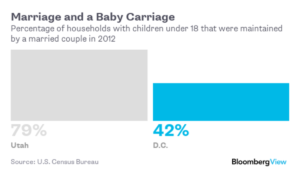Women and Family: How Utah Has Kept the American Dream Alive: Megan McArdle

published Mar 28th 2017, 5:00 am, by Megan McArdle
(Bloomberg View) —
There’s no getting around it: For a girl raised on the Upper West Side of Manhattan, Salt Lake City is a very weird place.
I went to Utah precisely because it’s weird. More specifically, because economic data suggest that modest Salt Lake City, population 192,672, does something that the rest of us seem to be struggling with: It helps people move upward from poverty. I went to Utah in search of the American Dream.
Columnists don’t talk as much as they used to about the American Dream. They’re more likely to talk about things like income mobility, income inequality, the Gini coefficient — sanitary, clinical terms. These are easier to quantify than a dream, but also less satisfying. We want money, yes, but we hunger even more deeply for something else: for possibility. It matters to Americans that someone born poor can retire rich. That possibility increasingly seems slimmer and slimmer in most of the nation, but in Utah, it’s still achievable.
If you were born to parents who were doing well, you are likely to be doing well yourself. If you were born to parents who were not doing well, then you are likely to repeat their fate. To take just one metric of many: In a society in which a college degree is almost required for entry into the upper middle class, 77 percent of people whose families are in the top quarter of the earnings distribution secure a bachelor’s degree by the time they are 24. For people in the lowest income bracket, that figure is 9 percent.
But things look a lot better in Salt Lake City, which economists Raj Chetty, Nathaniel Hendren, Patrick Kline and Emmanuel Saez identified as having the highest rates of absolute upward mobility in the nation. So I went to Utah to discover its secrets and assess whether they could be exported.
Once I got there, I found that it’s hard to even get a complete picture of how Utah combats poverty, because so much of the work is done by the Mormon Church, which does not compile neat stacks of government figures for the perusal of eager reporters.
The church did, however, give me a tour of its flagship social service operation, known as Welfare Square. It’s vast and inspiring and utterly foreign to anyone familiar with social services elsewhere in the country. This starts to offer some clue as to why Utah seems to be so good at generating mobility — and why that might be hard to replicate without the Latter-Day Saints.
Utah-Style Government There’s bad news and good news.
Bad news: The wide gulf between Utah and, say, North Carolina implies that we do, in fact, have a real problem on our hands. A child born in the bottom quintile of incomes in Charlotte has only a 4 percent chance of making it into the top quintile. A child in Salt Lake City, on the other hand, has more than a 10.8 percent chance — achingly close to the 11.7 percent found in Denmark and well on the way to the 20 percent chance you would expect in a perfectly just world.
Good news: Because income mobility is not low everywhere, it looks like a problem with a solution. It’s not just a fact of life like earthquakes. If one place can give people a reasonable shot at moving up, then other places could presumably follow suit.
If we knew what Salt Lake City was doing right. Or even who was doing it.
“Big government” does not appear to have been key to Utah’s income mobility. From 1977 to 2005, when the kids in Chetty et al’s data were growing up, the Rockefeller Institute ranks it near the bottom in state “fiscal capacity.” The state has not invested a lot in fighting poverty, nor on schools; Utah is dead last in per-pupil education spending. This should at least give pause to those who view educational programs as the natural path to economic mobility.
But “laissez faire” isn’t the answer either. Utah is a deep red state, but its conservatism is notably compassionate, thanks in part to the Mormon Church. Its politicians, like Senator Mike Lee, led the way in rejecting Donald Trump’s bid for the presidency. And the state is currently engaged in a major initiative on intergenerational poverty. The bill that kicked it off passed the state’s Republican legislature unanimously, and the lieutenant governor has been its public face.
This follows what you might call the state’s “war on homelessness” — a war that has been largely victorious, with most of the state’s homeless resettled in permanent housing through a focus on “Housing First.” That means getting people into permanent shelter before trying to diagnose and address the problems that contributed to their homelessness, like mental illness and substance abuse.
This approach can be cheaper than the previous regime, in which too many individuals ended up in emergency rooms or temporary shelter seeking expensive help for urgent crises. But Housing First runs into fierce emotional resistance in many quarters, because it smacks too much of rewarding people for self-destructive behaviors. Utah’s brand of conservatism overcame that, in part because the Mormon Church supported it.
That’s the thing about the government here. It is not big, but it’s also not … bad. The state’s compassionate conservatism goes hand-in-hand with an unusually functional bureaucracy.
During the week I spent in Utah, I was astonished at how cheerful the civil servants were. They seemed to see no point in turf wars, as long as the work gets done by someone. Their poverty services programs use a “no wrong door” model, in which anyone seeking any sort of help is given a comprehensive assessment of all their needs. No one I talked to, even off the record, said they needed bigger budgets or more staff.
But if “better bureaucracy” is an answer to the problem of regional disparity in income mobility, it’s not a particularly hopeful one. Reforming a bureaucratic culture — staffed by people who cannot be fired without heroic effort, and who can organize to get their new boss unelected — is nigh on impossible. Replicating Utah’s civil service elsewhere might work in theory, but it won’t become reality.
But let’s not despair. A cheerfully effective bureaucracy is not the sole force that makes the American Dream possible in Utah. In fact, my time inside that bureaucracy pointed me again and again toward a more significant factor.
People in Utah’s government casually talk about getting the community involved in their efforts, not as a rote genuflection to a political ideal, but as an actual expectation. “Government’s not going to solve all this, and that’s why you’re in the room,” Lieutenant Governor Spencer Cox said to attendees of a community meeting about the Intergenerational Poverty Initiative, and it wasn’t just an idle hope. Utah really does have an immense parallel structure that can be counted on to bolster anything the government does on poverty. Its front door is Welfare Square.
The Mormon Welfare Network
Like most social service agencies, Welfare Square is in one of the less pretty parts of town, tucked just off the highway between industrial buildings and modest tract homes. The complex itself, incorporating public spaces where help is offered, and private spaces where the church manufactures many of the goods it gives away, is built of modest materials and is kept scrupulously clean. And it is vast.
Many charity operations offer a food pantry or a thrift shop. Few of them can boast, in addition, their own bakery, dairy operation and canning facilities, all staffed by volunteers. The food pantry itself looks like a well-run grocery store, except that it runs not on money, but on “Bishop’s Orders” spelling out an individualized list of food items authorized by the bishop handling each case. This grows out of two features of Mormon life: the practice of storing large amounts of food against emergencies (as well as giving food away, the church sells it to people for their home storage caches), and an unrivaled system of highly organized community volunteer work.
The volunteering starts in the church wards, where bishops keep a close eye on what’s going on in the congregation, and tap members as needed to help each other. If you’re out of work, they may reach out to small business people to find out who’s hiring. If your marriage is in trouble, they’ll find a couple who went through a hard time themselves to offer advice.
But it does not stop with informal networks. Mormon youth are encouraged to go on missions. Many of them evangelize, of course, but others end up doing work for the church, including at Welfare Square. Every Mormon is expected to skip two meals a month, and to donate at least the value of the food they would have bought (and preferably more) to help the needy. They’re also encouraged to volunteer for the church. A job center at Welfare Square harnesses the still-prodigious energies of retirees; when I was there, an immigration center, also staffed with volunteers, was just starting up. The assistance offered is not unique, but the sheer scale of it is; few other churches could muster a similar army of willing, helpful people, or deploy them so efficiently.
The Mormon Church has a particular philosophy of help. Don Johnson, division director for the Welfare Department of the Church, spoke of the Pharisees quizzing Jesus in the gospels: “They asked the savior what is the greatest commandment — love God, and love your neighbor.” For the Mormon Church, that means making sure that no one goes hungry.
But the church is quite clear that the help is a temporary waypoint on the road to self-sufficiency, not a way of life. People are asked to work in exchange for the help they get, and, as the bishop said, “We make a list of what will sustain human life, not lifestyle.” I sampled various of the food items, and all were perfectly tasty, but nothing was what you would call fancy. It’s a utilitarian stopgap, not a substitute for an income, and not meant to be; the help comes with a healthy push to get yourself back on your feet as quickly as possible. The two phrases I heard over and over were “individual” and “self-reliant.”
“It’s a failure on the part of many,” he said, “if this is going on for six months or a year and their condition hasn’t changed.”
This combination of financial help and the occasional verbal kick in the pants is something close to what the ideal of government help used to be. Social workers used to make individual judgments about what sort of help their clients needed or deserved. But such judgments always have an inherently subjective and arbitrary quality, which courts began to frown on in the middle of the 20th century, in part because they offered considerable discretion for racial discrimination.
Turning government welfare into an automatic entitlement based on simple rules undoubtedly made it fairer, and kept people from slipping through the cracks. But making it harder to remove benefits from people who stopped trying also made it easier for people to make understandable short-term decisions which turned into long-term dependence, leaving a significant number of people disconnected from work and mired in multi-generational poverty.
That’s what the Mormon approach to support avoids. It gets people back on their feet and connects them with their communities. At its best, it provides a path from the bottom quintile to the top.
Is Mormonism really essential to this approach? Perhaps other communities could incorporate lessons from the church’s good works.
Mobile Middle Class
When Chetty et al released their study of levels of income mobility in various parts of America, their most interesting finding was not about “the 1 percent.” In fact, the inequality that best predicted low mobility was within the 99 percent — the distance between a community’s upper middle class and its poorest citizens.
This makes some sense. Realistically, few strive to join the 1 percent. But children from any background should be able to look around their communities and see models for more ordinary kinds of success: doctors, lawyers, engineers. If those denizens of the upper middle class are earning a lot more than the poorest people in the area, the rungs of the ladder are just too far apart, and few will be able to climb.
Income is hardly the only thing holding people down. Children who start life in affluence also have access to social networks that instill values — like emphasizing going to school and not having children until you can support them — and provide connections to the professional world.
David Sims, a Brigham Young economist who has done work on income mobility, suggests that the secret to Utah’s especially good mobility is not that it’s especially good at building effective public institutions. What it’s especially good at is a sort of middle classness that’s so broad it’s almost infectious.
Sims has looked at what happens to kids from schools in pairs of counties located along state borders, which provides something close to a natural experiment. Adjacent counties can be assumed to have broad overlap in the kind of people and businesses that locate there but will, because of their different state governments, have different levels of school funding and institutional practices. Sims found this made “almost no difference.”
So he asked, in his words, “What are schools doing?” Answer: exposing students to social networks that aren’t like theirs.
That happens organically in an area where all the schools are pretty much the same, with a strong mixing of the top and the bottom classes. That mixing can even be intentional and can happen outside of school; another economics professor at Brigham Young told me that his church ward had recently deliberately expanded its boundaries to include a nearby trailer park.
The promise of this approach to mobility is actually somewhat disheartening to advocates. A conversation about the 1 percent versus the 99 percent points toward some solutions the government is good at — like taxing a tiny number of rich people and redistributing the money to those further down the income scale. But if the more promising solution to income mobility is to create a viable path from poverty to the upper middle class, then political support will tend to disappear. The class of liberal professionals who talk about reducing income inequality are not threatened by talk of taxing the 1 percent. But they would lose out from a broad equalization of incomes between the top 25 percent and the bottom 25 percent.
How did Utah manage, then? Well, one viable theory is “it’s Mormon.” Churches form a sort of leveling community. No matter what we do outside, we’re all equal before God.
There’s a more troubling theory: that at least some of Utah’s success lies in its lack of racial diversity. Which is itself no accident.
The Race Factor
One astonishing feature of Utah is how little people talk about race. At that community meeting on the Intergenerational Poverty Initiative, all the usual people were there: civil servants and teachers, politicians, the folks who do charity work in the community, and the inevitable scattering of retirees who now have time to take an interest in politics. My notes on the meeting do not contain the word “race,” and as far as I can recall, no one mentioned it. No proposal was immediately decried as racist. Truly surreal to a Washingtonian and a recovering New Yorker. What’s happening here?
The state population is now about 13 percent Hispanic, but only 1 percent black. Part of the explanation is probably the Mormon Church’s century of institutional racism.
During the era of founder Joseph Smith, the church actually seems to have been relatively egalitarian for its time. But his successor, Brigham Young, who led the Latter-Day Saints to Utah, excluded black followers from the priesthood (which is generally open to every Mormon man), keeping them out of the center of ecclesiastical life. The doctrine did not change until 1978, and the church’s racist past still lingers.
Unsurprisingly, the Mormons did not attract many black converts during the century that the ban was in place. Given that Utah is primarily peopled by Mormons, its population skews white. (The church is now winning souls in Africa, but its home city remains remarkably white.)
This near-absence of racial diversity means that racism is largely left out of Utah’s conversations about economic inequality. That leads to some conversations around inequality that would be unbearably fraught elsewhere. When the poor people are, by and large, the same race as the richer ones, people find it easier to talk about them the way they might talk about, well, family members — as folks who may have made some mistakes and started with some disadvantages, but also as folks who could be self-sufficient after a little help from an uncle or a sister. It’s a very different conversation from “victim”/“oppressor” and “us”/“them”: a conversation that recognizes that poor people often make choices that keep them in poverty, but also that the constraints of poverty, including the social environment of poor neighborhoods, make it very difficult to make another choice.
It’s not clear that we can have those same sorts of conversations in the places that are still struggling more openly and frequently with the legacy of slavery, or the inevitable clashes that come from throwing a lot of different cultures together in a small space. The many benefits of diversity have been so frequently and thoroughly extolled that I need not rehearse the refrain here. But there has been a growing disquiet in recent years with diversity’s costs. About 10 years ago, public policy professor Robert Putnam began quietly pointing out that along with enhancing positive qualities like creativity, diversity also created conflict and reduced the level of social trust.
“In more diverse settings,” suggests Putnam, “Americans distrust not merely people who do not look like them, but even people who do.”
Utah’s willingness to help, and its ability to help, may arise from its homogeneity — a trait that won’t be exported to the diverse nation at large.
The Source of Stability
Utah is an aberration in many other ways. Look at alcohol and marriage.
The Mormon Church forbids drinking, and alcohol sales are far lower here than in other states. The incidence of problems associated with alcohol — like poverty, unemployment and crime — is also lower than in most other states.
On the other hand, the Mormon Church strongly encourages marriage, and the state is №1 in both married adults and in the percentage of children being raised by married parents.
Chetty et al suggest that having two married parents is a bedrock foundation of economic mobility — one that is rapidly eroding in modern America.
Economists Isabel Sawhill and Ron Haskins famously estimated that we could reduce poverty by 71 percent if the poor did just four things: finished high school, worked full time, got married and had no more than two children — and the number of children was the least important factor in that calculation.
By encouraging members to marry, the Mormon Church is encouraging them to reduce their own likelihood of ending up poor. But it may also be creating spillover effects even for non-Mormons, because Chetty et al didn’t just find that married parents helped their own children to rise; they also influenced the lives of the children around them.
“Parents’ marital status does not matter purely through its effects at the individual level,” they write. “Children of married parents also have higher rates of upward mobility in communities with fewer single parents. Interestingly, we find no correlation between racial shares and upward mobility once we control for the fraction of single parents in an area.”
In other words, while areas with high numbers of racial minorities did, in general, have lower levels of mobility (for whites as well as blacks), once they controlled for the family structure of the community, that effect disappeared. Marriage seems to have more of a correlation with mobility than race does. Homogeneous Utah is the real-world laboratory that bears out this theory, which in more diverse communities can be obscured by racism and racial activism.
The value of married parents — even if they aren’t your parents — may come from the peer effects that David Sims talked about. Neighborhoods model adulthood for kids. If you live in a neighborhood full of single mothers who had a hard time finishing school, that’s probably the future you’ll expect for yourself and your own kids. If you live in a neighborhood full of thriving two-parent families, that’s probably the future you’ll envision, even if your own father disappeared when you were 2. Marriage matters at the individual level, but it also matters at the community level, because the community can strongly shape individual behavior.
And this shaping is a two-way street, as George Orwell once pointed out about employment in Britain’s depressed industrial north. When most people are working, the community can help encourage those who are having trouble staying in work by lauding the working man and stigmatizing those who don’t. But when large percentages of the population are out of work, that norm collapses, because people are now being asked to stigmatize large numbers of their family and friends. The result is a vicious circle where work is not only harder to get, but harder to get people to do.
Marriage seems to be in just such a state of semi-collapse among large swathes of the population. The pattern of family formation that is becoming increasingly standard among the majority of the population that doesn’t have a college degree consists of weakly attached fathers, often supporting multiple children with multiple mothers, leaving their attention and resources divided among households.
It’s not that it’s impossible to have stable unions without a marriage certificate — it’s common in Scandinavia, for example, and same-sex parents formed households before they could legally marry — but that’s mostly not how it has worked out in the U.S., where the college educated marry late and form what sociologist Kathryn Edin calls “super-relationships.” These are partnerships of equals with very high degrees of satisfaction and economic success. Meanwhile people without a degree often don’t marry until after they’ve had kids, if they marry at all, and frequently struggle to raise their children in a tangle of shifting cross-household relationships.
“When I look at the data, I cannot find cohabiting couples that last very long,” says Joe Price, an economist at Brigham Young who studies marriage and family.
Utah has not entirely escaped the change, but it is relatively insulated; the state leads the nation for marriage and for children with married parents. How do we get Utah’s results without marriage?
“Why don’t we use what we have?” Price asked. “You’ve got this institution that has worked for thousands of years.” And yet, he said, “there’s a reluctance to use the word ‘marriage’ in public policy.”
People who don’t see why you need a marriage certificate to make a stable home for a child may be skewed by their own social position, Price said: “We’re always looking at the wrong group — the high-income group.” He added: “The people who are doing the research are the people who don’t need marriage.”
Utah’s unique religious history not only democratized the relationships between the affluent and the struggling; it also democratized marriage, at a time when elsewhere in the U.S., marriage seems to be morphing into an elite institution. Price thinks that gives the state a huge boost in launching kids into the middle class, and Chetty et al’s data back that up.
This does raise some questions about the viability of Utah’s “compassionate conservative” model outside the state. The vast welfare infrastructure from the Mormon Church naturally makes it easier to have smaller government. Perhaps that could be replicated by other communities. But the values of the Mormon Church may create a public that simply needs less help. That’s harder for another community to imitate. I’m not sure this key ingredient is available in a secular version; I think religion might only come in religion flavor.
How the heck is some state government supposed to get people to marry, and stay married?
Can Utah’s Mobility Be Replicated?
Utah’s incredible levels of integration, of community solidarity and support, of trust in government and in each other, enable it to build something unique in America, something a bit like Sweden might be, if it were run by the U.S. Chamber of Commerce. Where the best ideas of conservatives and liberals came together in one delicious package: business friendly, opportunity friendly, but also highly committed to caring for the needy and helping them get back on their feet. (And before you start muttering words like “theocracy,” let me point out that Salt Lake City also has a thriving LGBT community, and alone in the middle of the post-Obergefell culture wars, managed to bring that community together with religious leaders to hammer out a compromise that protected LGBT rights while also leaving some space for religious liberty.)
No place is perfect. But with mobility seemingly stalled elsewhere, and our politics quickly becoming as bitter as a double Campari with no ice, I really, really wanted to find pieces of Utah’s model that could somehow be exported.
Price gave me some hope. The Mormon Church, he says, has created “scripts” for life, and you don’t need religious faith for those; you just need cultural agreement that they’re important. He said: “Imagine the American Medical Association said that if the mother is married when she’s pregnant, the child is likely to do better.” We have lots of secular authorities who could be encouraging marriage, and volunteering, and higher levels of community involvement of all kinds. Looking at the remarkable speed with which norms about gay marriage changed, thanks in part to an aggressive push on the topic from Hollywood icons, I have to believe that our norms about everyone else’s marriages could change too, if those same elites were courageous enough to recognize the evidence, and take a stand.
And as I saw myself, Mormonism also seems to have a script for a different kind of politics, one that might, just possibly, help us do some of the other things. Enough to make a difference.
President George W. Bush talked a lot about compassionate conservatism 15 years ago, but Utah has made it a reality. Utahans seem strongly committed to charitable works, by government, alongside government or outside government. Whatever tools used are infused with an ethic of self-reliance that helps prevent dependency. And yet, when there’s a conflict between that ethic and mercy, Utah institutions err on the side of mercy.
America could use a politics more like that. And the values that make it work are not unique to Mormonism; nothing that they say is strikingly different from anything the religious right professes. Nor does Christianity have a monopoly on helping others and building strong communities; those are central tenets of a lot of religions, and are secular priorities.
We are not going to be a majority Mormon nation; we are not going to have Utah’s cultural homogeneity. But we could have more politicians like Lieutenant Governor Cox, and even more honest and sympathetic conversations about poverty. We could offer more, and better, help to people who need it. Why not look for more promising scripts than the ones played out across the U.S. today? With inspiration from Utah, perhaps the U.S. could inch toward Utah-level mobility — and toward the American Dream.
This column does not necessarily reflect the opinion of the editorial board or Bloomberg LP and its owners.








No Comment